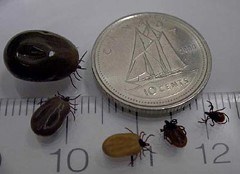Saskatchewan residents are being reminded to watch for ticks as they venture outdoors this spring.
Ticks are most often found in tall grass, brush or wooded areas. They cannot jump or fly but will grasp onto people or pets who brush up against them.
"People should be vigilant and check for ticks on themselves, their children and their pets after being outside," Saskatchewan Chief Deputy Medical Health Officer Dr. Julie Kryzanowski said. "Taking precautions against ticks is the best way to reduce the risk of a tick bite."
To prevent tick bites:
- Wear light-coloured clothes so ticks can be easily seen.
- Wear pants, long-sleeved shirts, and shoes that do not expose bare feet.
- Pull socks over pant legs to prevent ticks from crawling up legs.
- Use insect repellents that contain DEET or Icaridin. Apply repellent to clothes as well as skin. Always read and follow the directions on the label. Some repellents may have age restrictions.
- In Canada, clothing that has been treated with the insecticide permethrin has been approved for use by people over the age of 16.
- Shower or bathe as soon as possible after being outside to wash off loose ticks and inspect for attached ticks.
If a tick is found attached to skin or on your pet:
- Carefully remove it with fine-tipped tweezers and grasp the tick's mouthparts as close to the skin as possible.
- Pull slowly upward and out with firm, steady pressure.
- Be careful not to squeeze, crush or puncture the body after removal.
- Do not put Vaseline, gasoline, or other harmful substances on an attached tick.
- Submit photos of the tick using the eTick system (www.etick.ca), and keep ticks in a secure container until you receive the identification results. Ticks can be euthanized by placing them in a bag and storing it in the freezer 24 hours.
Most ticks found in Saskatchewan are the American dog tick. This species is active from mid-April to the end of July and cannot transmit Lyme disease to people.
The risk of exposure to Lyme disease is low in Saskatchewan, according to the Ministry of Health.
Blacklegged ticks, which can cause Lyme disease, are rare in Saskatchewan, though they can be introduced by migratory birds in early spring and remain active throughout fall.
In 2021, 969 ticks were identified in Saskatchewan and only 15 were blacklegged ticks. Nine of these were submitted for testing and none of them tested positive for the bacteria that causes Lyme disease. the ministry reports.
For more information on ticks and Lyme disease, including how to submit a tick for identification and testing, visit saskatchewan.ca/lyme or https://research-groups.usask.ca/ticks/#Passivesurveillance.




